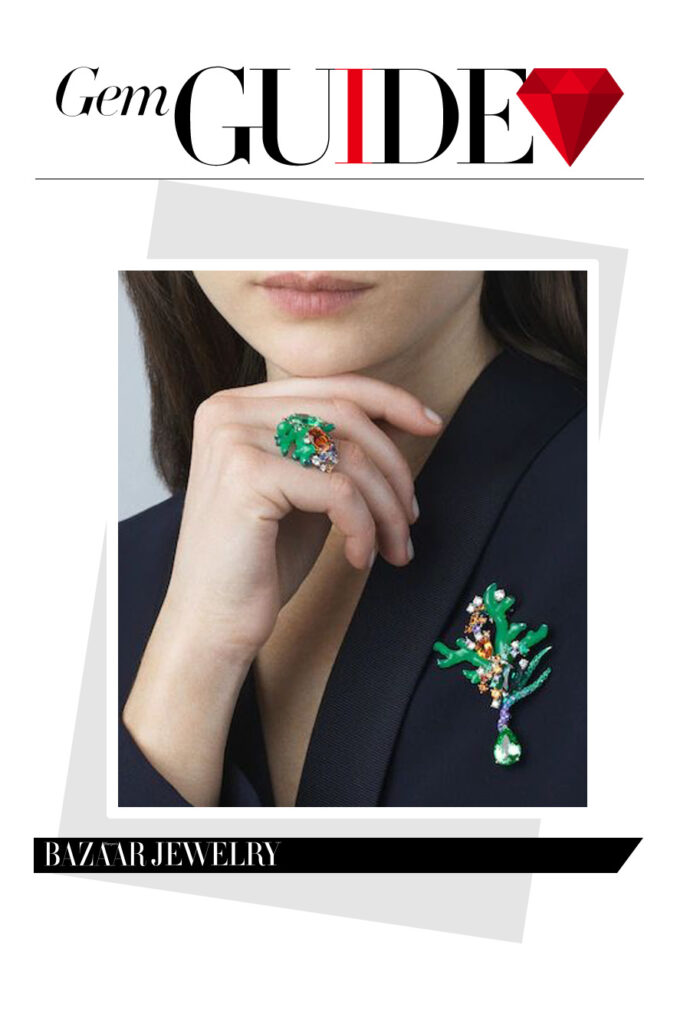
Many jewelry enthusiasts mistakenly believe that garnets are merely semi-precious stones with little presence in high-end jewelry and limited collectible value.
However, this perception couldn’t be further from the truth. The garnet family boasts several high-value and highly sought-after members. Among these are the fresh and vibrant tsavorite, beloved in jewelry circles; the bold and passionate spessartine; and the “collector’s holy grail” demantoid. It’s fair to say that this extensive family is brimming with visually stunning members.
Let’s begin our exploration with the lively tsavorite garnet. Many refer to tsavorite as an “emerald alternative” due to their strikingly similar colors. This similarity stems from the shared chromophores in both gems – chromium and vanadium – which produce that vibrant green hue. The scientific name for tsavorite is chrome vanadium grossular garnet, and it’s a relatively young member of the garnet family.
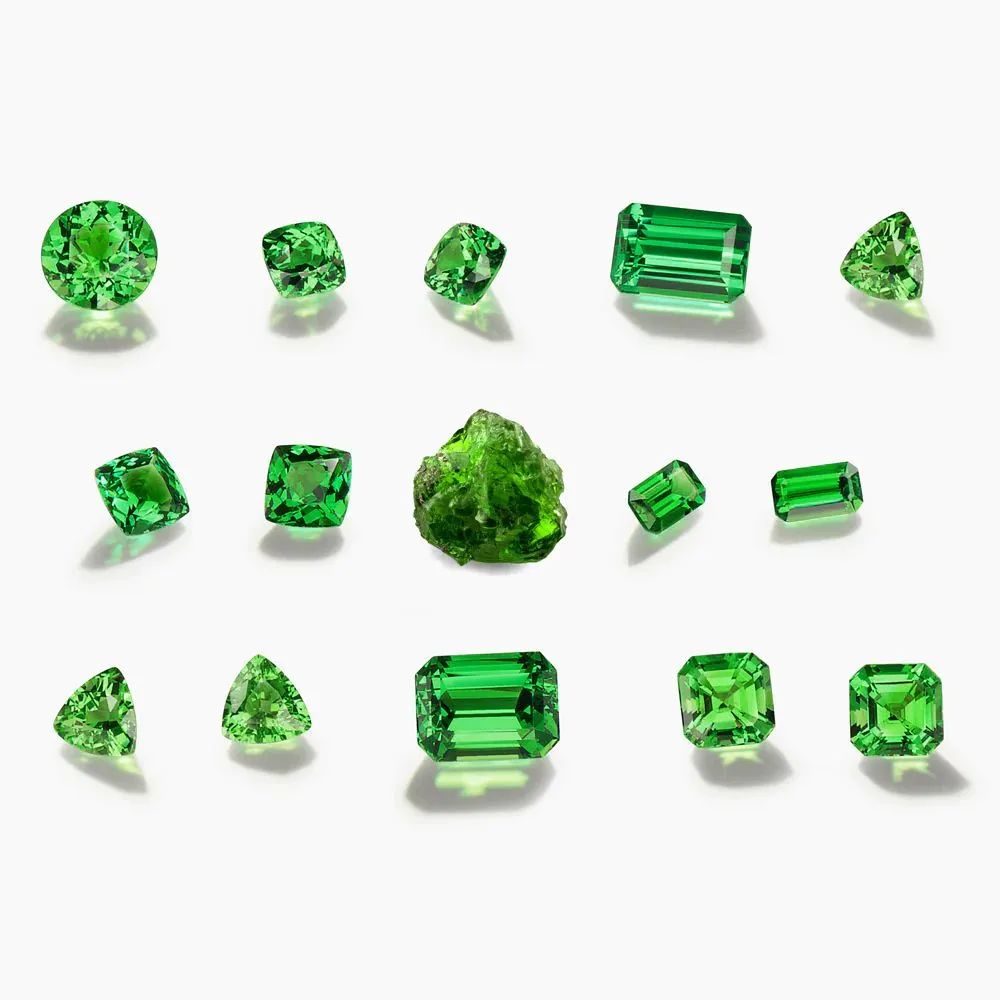
While red garnets have been popular since the Victorian era, this green variety wasn’t discovered until 1967. British geologist Campbell R. Bridges made the discovery near Kenya’s Tsavo National Park. He found what is now known as the “Scorpion Mine,” the source of high-quality tsavorite.
However, it was Harry Platt, former chairman of Tiffany & Co. and great-grandson of Louis Comfort Tiffany, who named the gem. Platt was also instrumental in popularizing both tanzanite and tsavorite.

2022 Blue Book High Jewelry Collection
Botanica Jean Schlumberger Chapter
Tsavorite and Diamond Earrings
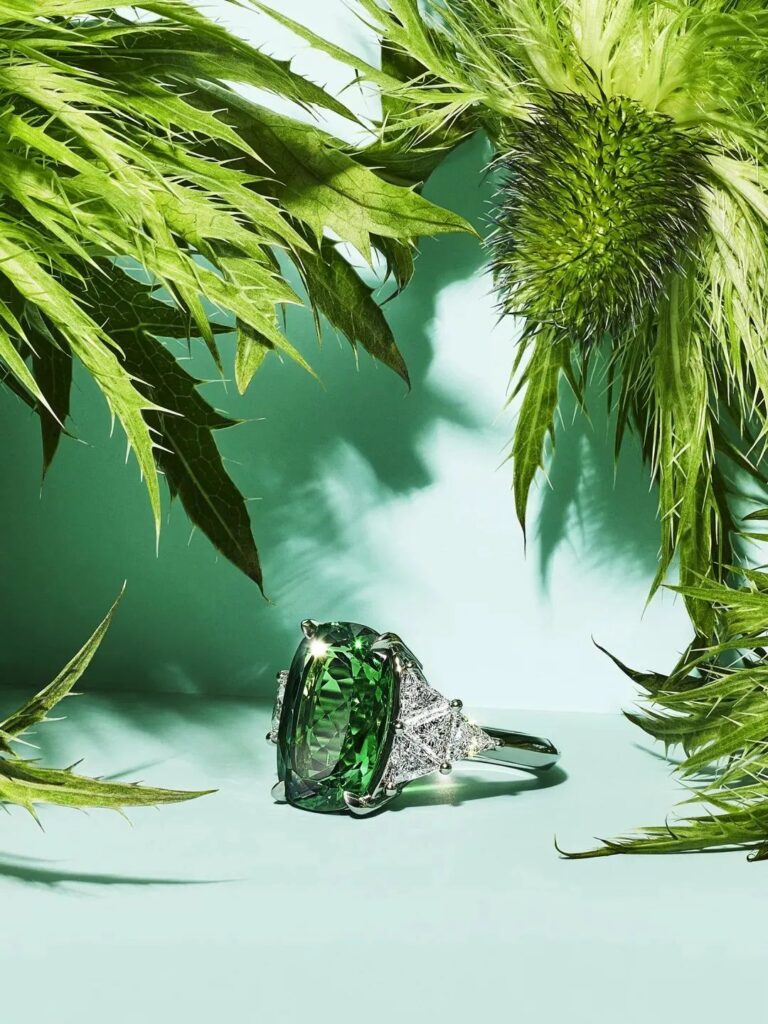
2022 Blue Book High Jewelry Collection
Botanica Ring Tsavorite and Diamond
Harry Platt named this newly discovered green gemstone Tsavorite, in honor of its place of discovery (which also makes it difficult to discern its “true identity” from its name). Although tsavorite has since been found in other parts of Tanzania and Kenya, high-quality tsavorite with pure green hues is still only found in Tsavo, Kenya.
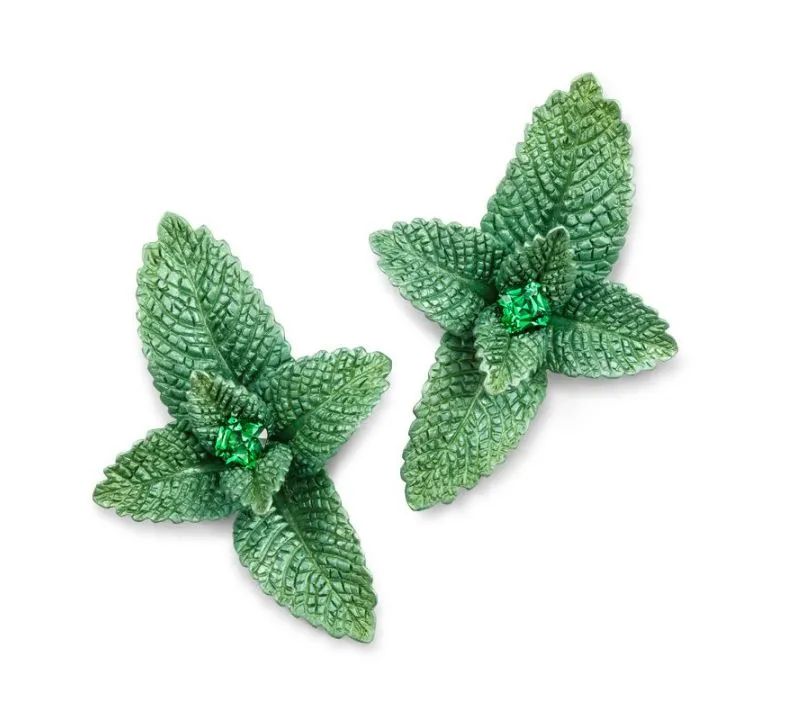
Infused Jewels Collection
Lemon Balm Earrings
Aluminum, platinum, tsavorite
Despite its late discovery, tsavorite quickly rose to prominence. It was introduced to the high jewelry world by Tiffany & Co., making its dazzling debut in their 1974 Blue Book high jewelry collection. Of course, tsavorite’s “beauty” speaks for itself. Its green color is exceptionally bright, appearing more youthful and vibrant compared to the deep green of emeralds. It has a brilliant yellow undertone that evokes images of early summer forests, full of vitality.
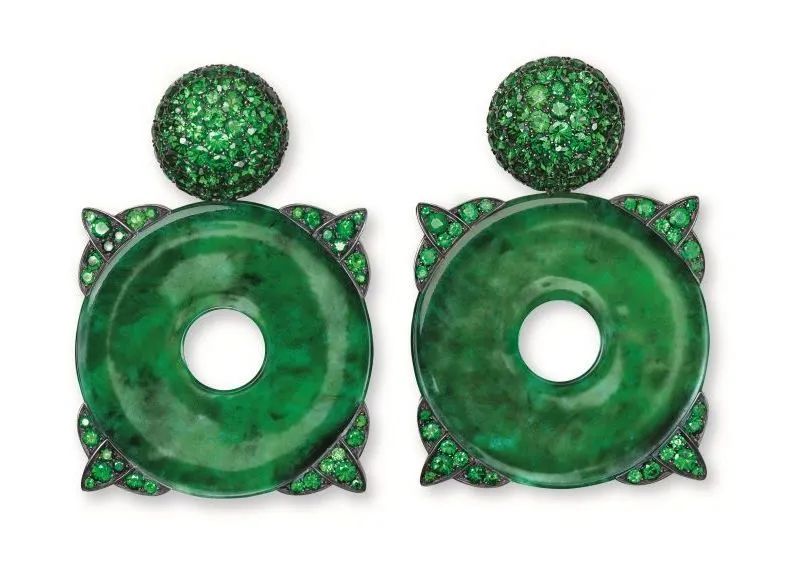
Jade, tsavorite
One of tsavorite’s major advantages is its high clarity. Moreover, its impressive dispersion and high refractive index give it a more brilliant fire.
In 2023, the Gübelin Gem Lab introduced a new commercial name for tsavorite – “Kijani Green.” The most crucial criterion in their assessment standard is the gem’s dazzling brilliance. Only tsavorites with high saturation and appropriate brightness can receive the “Kijani Green” grade.
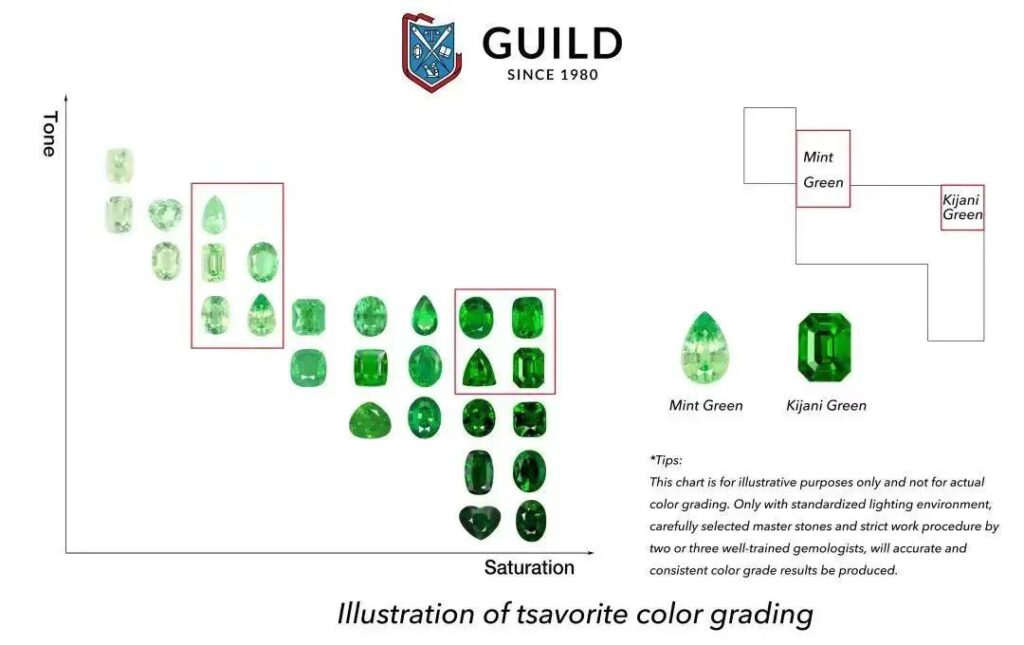
“Kijani” in Swahili means a bright green full of hope, which is the highest praise for green given by the Swahili people, one of the main ethnic groups in Kenya and Tanzania, where tsavorite is primarily mined.
In terms of the 4Cs, tsavorite’s only weakness is the rarity of large carat stones. About 85% of tsavorites on the market are under 1 carat, with stones over 3 carats considered collection-grade. Large carat tsavorites are rarely seen, except in high jewelry collections from top brands. For instance, the 65.25-carat oval-cut tsavorite in Louis Vuitton’s Spirit high jewelry collection is truly a “ceiling-level” gem.
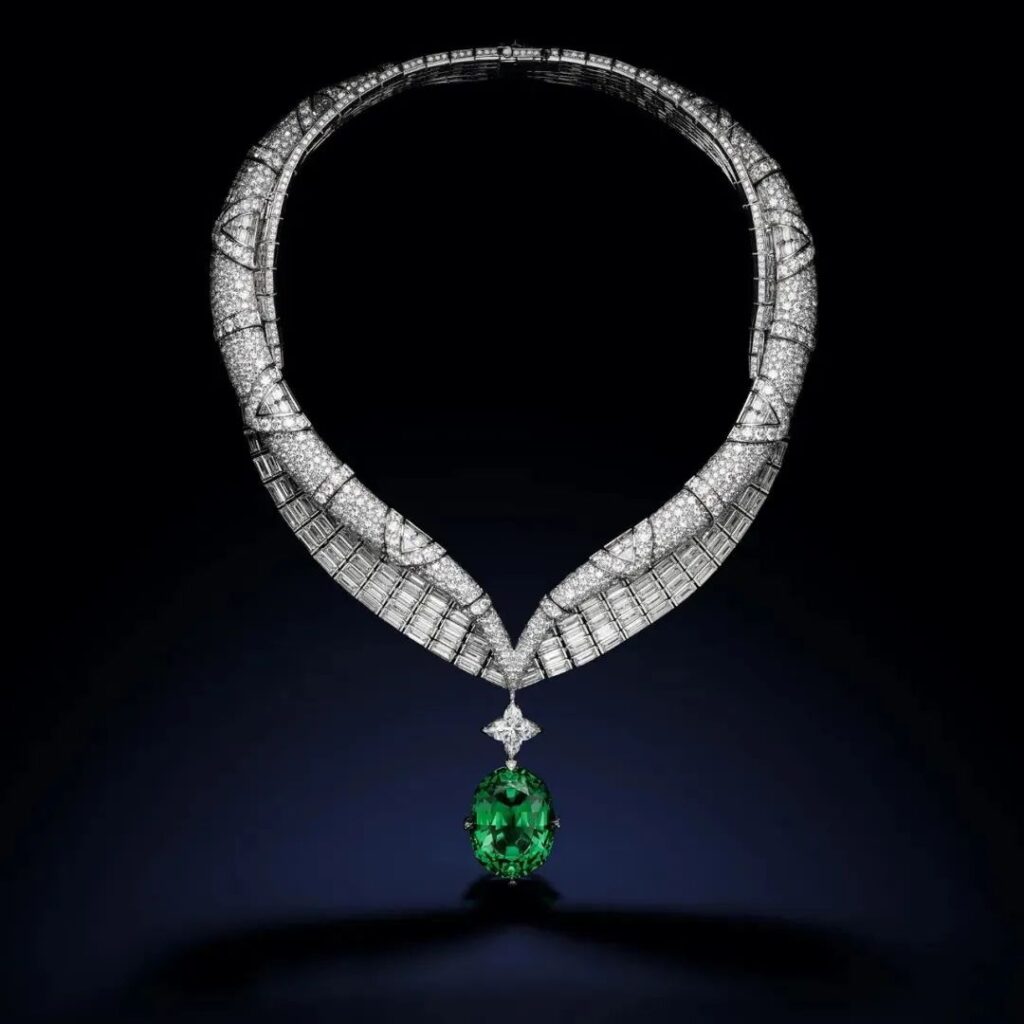
Spirit High Jewelry Collection, Grace Necklace
Set with a 62.25-carat oval-cut tsavorite
Tsavorite’s rapid rise in the high jewelry world is not only due to its beauty but also its rarity.
This gemstone is typically found in rock fissures, making it difficult to mine. High-quality deposits are scarce, and in fact, it’s rarer than emerald. Moreover, it’s one of the few gemstones that cannot be synthesized artificially. So despite its late “debut,” tsavorite started at a high point and easily became a hot commodity in the high jewelry circle.
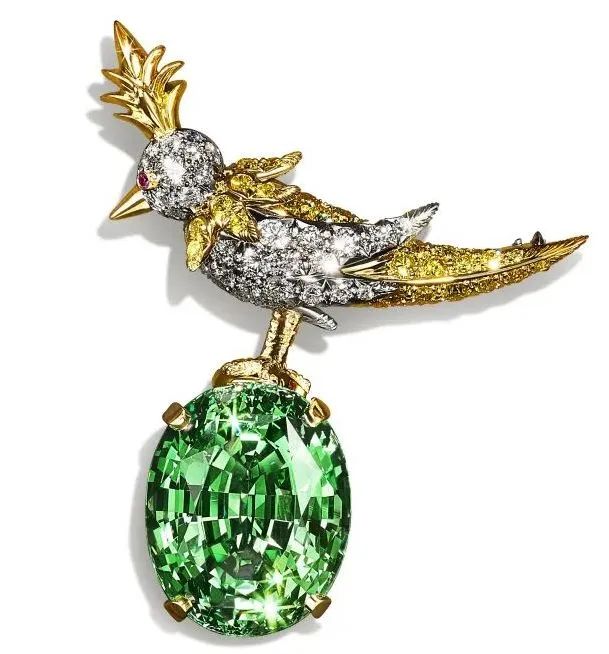
2022 Blue Book High Jewelry Collection
Botanica Bird on a Rock Brooch
Yellow gold, white gold, tsavorite, diamonds

Majestic Escapes High Jewelry Collection
Rainforest Necklace
Tsavorite, diamonds
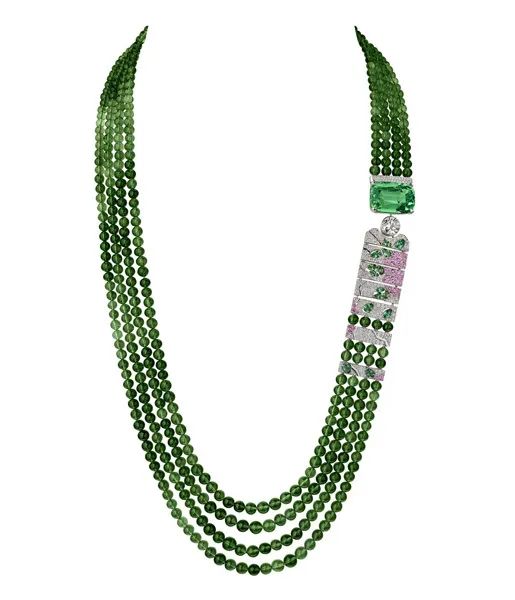
Espiration Florale Necklace
White gold, tourmaline, diamonds, sapphires, tsavorite
Although tsavorite typically occurs in small sizes, the use of pavé setting techniques can greatly enhance its brilliant fire, creating an intense green effect.
Jewelry designer Glenn Spiro is undoubtedly a master in this realm. He adores tsavorite and understands how to create fresh, natural effects: the setting of stones of varying sizes, heights, and depths, each with its own subtle intricacy, achieves a lush, vibrant green appearance.
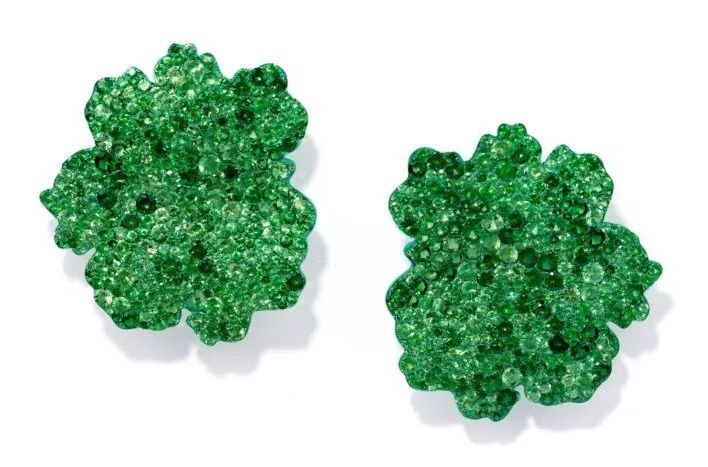
Titanium and tsavorite earrings
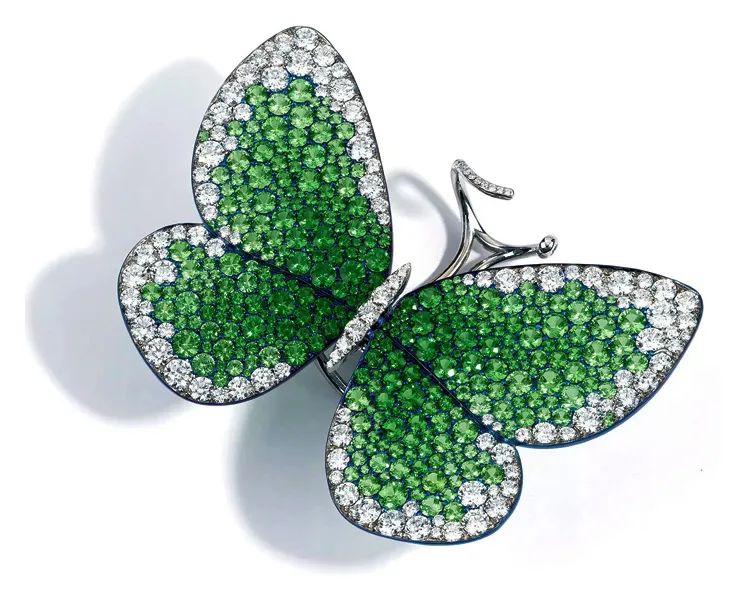
Papillon Ring
Titanium, tsavorite, diamonds
In addition to the previously mentioned “Kijani Green” tsavorite, another variety called “Mint Green” by Gübelin is also popular in the jewelry world. It has a completely fresh, artistic appeal with a clear, transparent quality.
Chaumet Paris chose this stone to represent the underwater world, pairing it with similarly colored chrysoprase and bluish-green tourmaline, contrasting it with vibrant spessartine garnet to create a rich, colorful underwater scene.
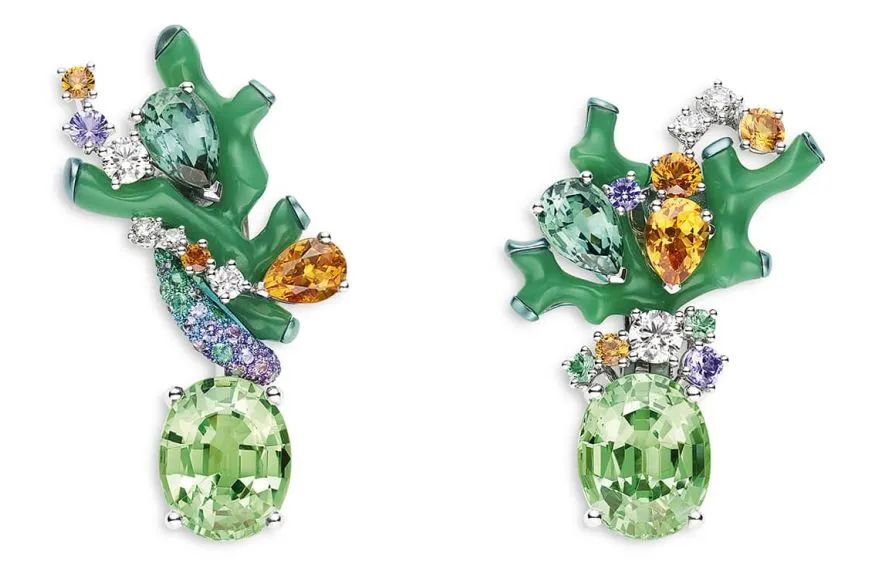
Ondes et Merveilles High Jewelry Collection
Treasure Hunt Earrings
White gold, titanium, tsavorite, spessartine garnet, chrysoprase, tourmaline, sapphire, emerald, diamonds
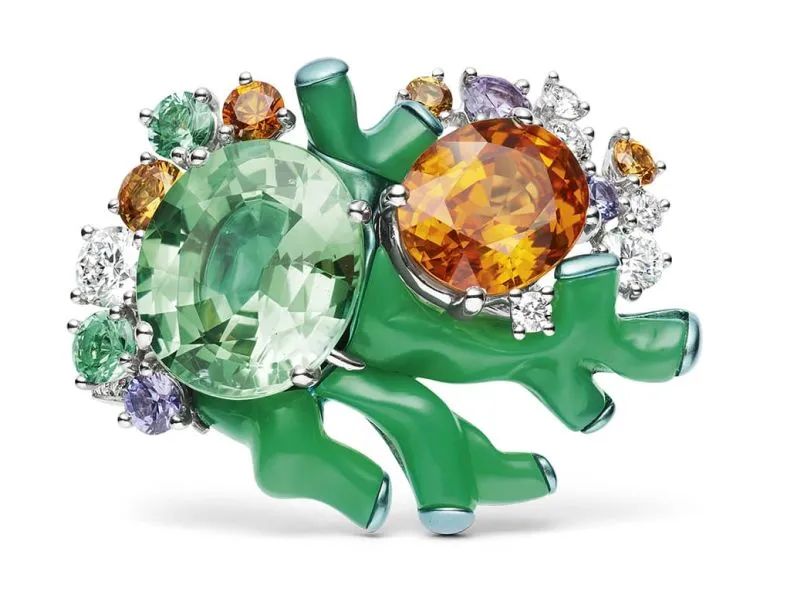
Ondes et Merveilles High Jewelry Collection
Treasure Hunt Ring
White gold, titanium, tsavorite, spessartine garnet, chrysoprase, sapphire, emerald, diamonds
Speaking of spessartine garnet (also known as Mandarin Garnet), it’s another member of the garnet family. Its scientific name is manganese aluminum garnet, featuring yellow-orange to orange-red hues, often accompanied by silky healing fissures. With its vivid color and high saturation, it’s one of the rarer, high-value members of the garnet family.
However, not all manganese aluminum garnets can be called Mandarin Garnet; only those with a completely gray-free, vivid orange color qualify for this designation.
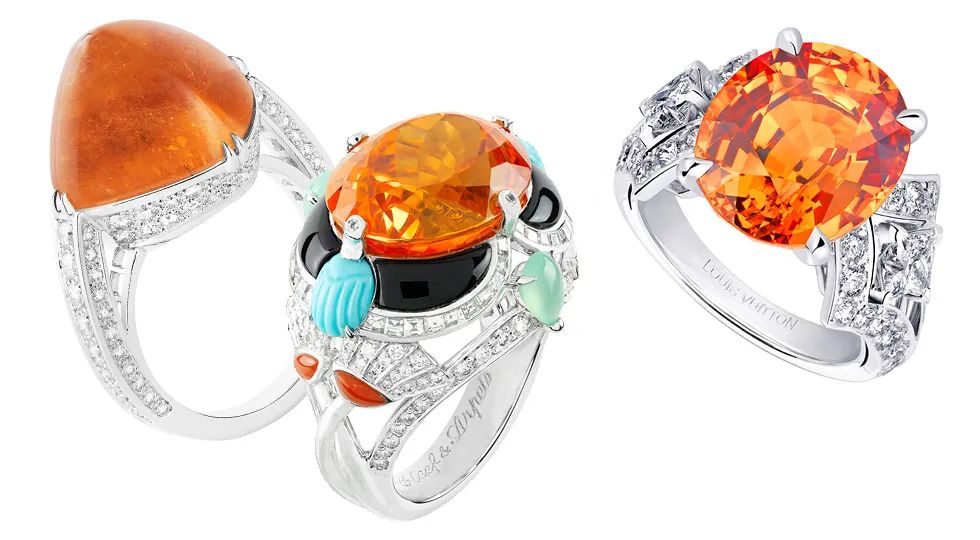
Boucheron Joy Ring
Mandarin garnet, diamonds
Van Cleef & Arpels Ring
Diamonds, turquoise, coral, chrysoprase, banded agate, mandarin garnet
Louis Vuitton Acte V Genesis Ring
Mandarin garnet, diamonds
Spessartine garnet was first discovered in 1880 in the German mountains, but it didn’t truly enter the jewelry world until the discovery of African Namibian veins in the 1990s. To this day, Namibia remains a renowned source of high-quality mandarin garnets. The manganese aluminum garnets found there possess a coveted “citrus color,” reminiscent of the popular Fanta drink, hence the name “Mandarin Garnet” or “Fanta Stone.”
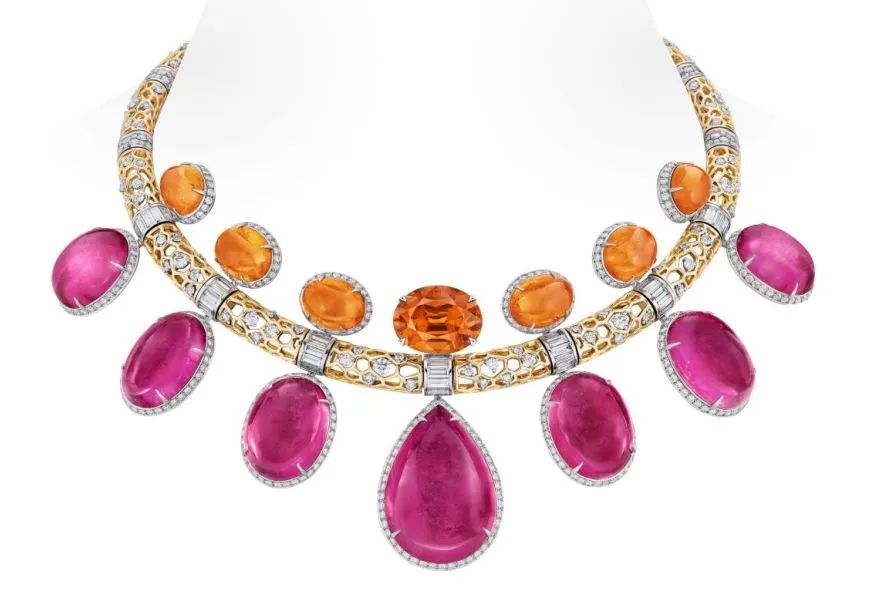
Deep Time High Jewelry Collection, Seed Necklace
Mandarin garnet, tourmaline, diamonds
Mandarin garnet shares similarities with tsavorite, boasting both high refractive index and hardness, resulting in brilliant fire. Its vibrant citrus color makes it highly noticeable. When first discovered, it was initially disliked for being too “eye-catching,” and it took nearly a century from its discovery to its acceptance in the jewelry world.
This was partly because it was the era of the “classic three treasures” – ruby, sapphire, and emerald – and the overly vivid mandarin garnet could only be used as an accent stone.
However, in recent years, mandarin garnet has successfully “risen to prominence,” frequently appearing as the centerpiece in high jewelry pieces from major brands. This has led to increasing recognition of this lively and gorgeous gemstone.
Whether it’s Louis Vuitton using it as the focal point of golden armor or Chanel pairing it with yellow diamonds for a dazzling effect, mandarin garnet never fails to catch the eye.
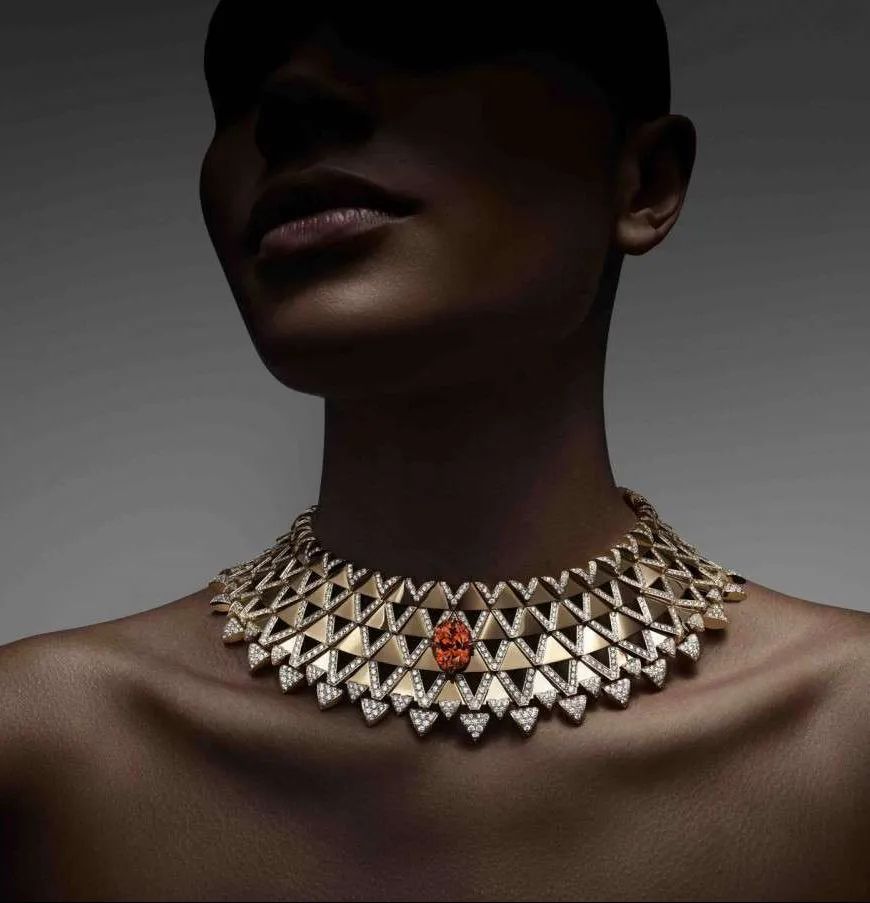

Spirit High Jewelry Collection
Radiance Necklace, Bracelet, Ring
Yellow gold, mandarin garnet, diamonds
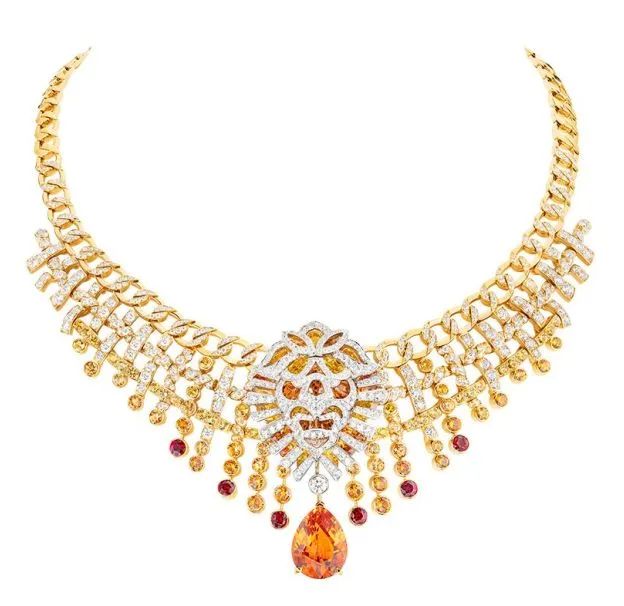
Tweed Gabrielle Necklace
Yellow gold, platinum, mandarin garnet, sapphire, diamonds
Bulgari, known for its vibrant color palette, could not possibly overlook the vivid mandarin garnet. Whether it’s creating harmony with analogous colors, combining mandarin garnet and citrine for a “sweet and sour” rhythm, or using contrasting colors like cool-toned turquoise and amethyst to highlight its warmth, Bulgari’s designs immediately showcase the liveliness and brilliance of mandarin garnet.
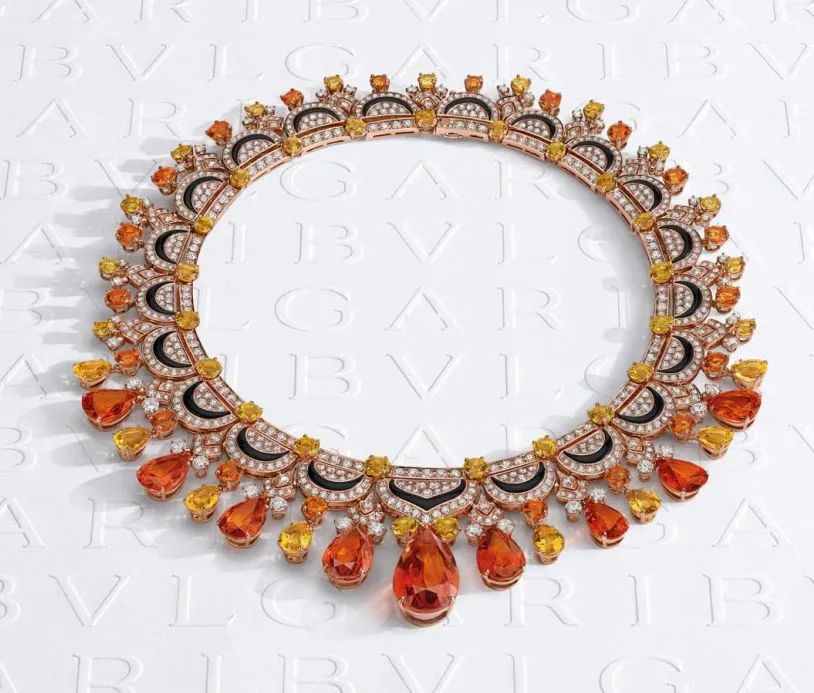
Mediterranea High Jewelry Collection
Oriental Fantasy Necklace
Mandarin garnet, mother-of-pearl, citrine, banded agate

Cinemagia High Jewelry Collection
Night at the Casino Necklace
16.85-carat mandarin garnet, amethyst, turquoise, diamonds
When it comes to the most valuable member of the garnet family, demantoid garnet takes the crown. Known as the “Tsar’s Stone,” it possesses the strongest fire among green gemstones. Its dispersion rate is an impressive 0.057, even surpassing the famous fire of diamonds (dispersion rate 0.044).
This is why its English name “Demantoid” means “diamond-like,” making it arguably the most dazzling star in the garnet family.
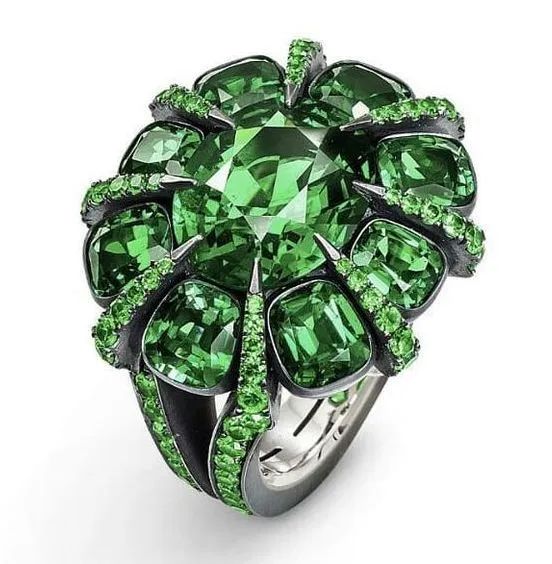
White gold, tsavorite, demantoid garnet
Demantoid garnet was discovered in the early 19th century in Russia’s Ural Mountains. In 1854, renowned mineralogist Nils Gustaf Nordenskiöld identified this gemstone as andradite garnet. In 1871, the Russian Imperial Mineralogical Society named it “Demantoid” due to its extraordinary brilliance and dispersion.
Consequently, it became a favorite of Russian tsars and found its way into Europe, becoming particularly popular in Belle Époque (1890-1915) and Art Nouveau jewelry.


Art Nouveau pendant
Demantoid garnet, sapphire, opal
Unlike the high clarity of tsavorite and mandarin garnet, demantoid garnet possesses a unique horsetail-like asbestos inclusion. This feature further increases its value, earning it the title of “the world’s most expensive inclusion.”
In the past, it was believed that only Russian demantoid garnets contained these “horsetail” inclusions, giving Russian demantoids a provenance premium similar to Burmese rubies or Colombian emeralds.
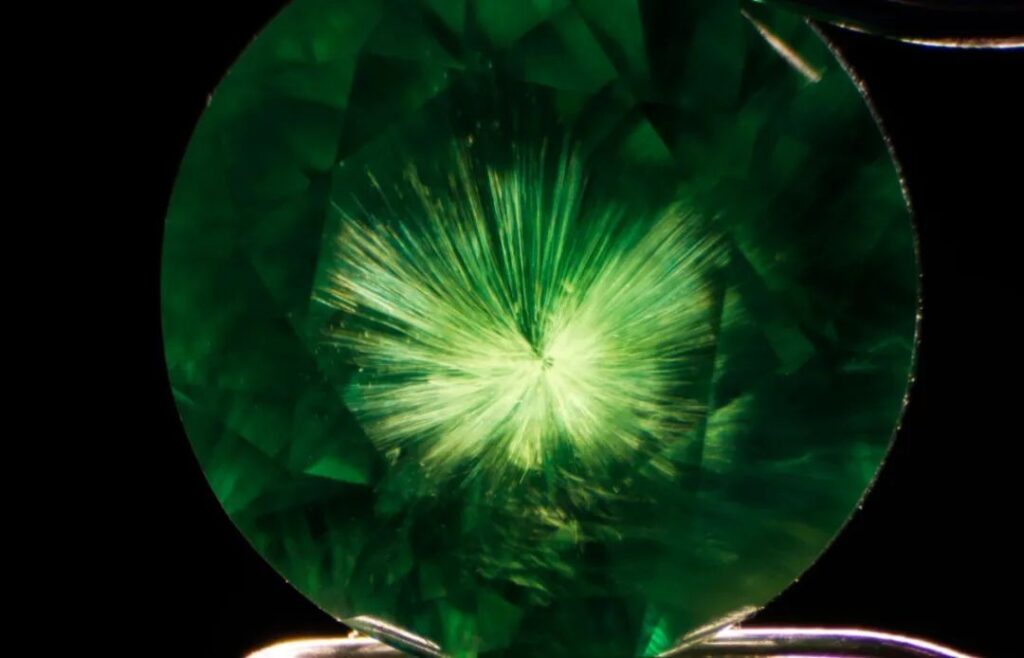
Later, demantoid garnets were also discovered in Iran, Namibia, and Madagascar. However, according to research by Tsarina Jewels, a Russian jeweler specializing in demantoid garnets, while demantoids from other locations may also have “horsetail” inclusions, they often appear as a single line or irregular shape.
Only Russian demantoids frequently feature “horsetail” inclusions that radiate from the center of the stone like fireworks. Therefore, to this day, Russian demantoids are still considered the most prestigious.
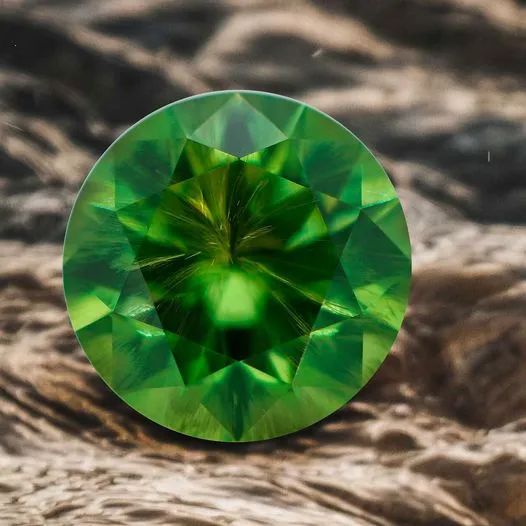
Demantoid garnets rarely occur in large sizes. Most demantoids are under one carat, and a high-quality demantoid of two carats is considered extremely rare. A demantoid over five carats of exceptional quality can be classified as a world-class gemstone.
In 2008, a ring featuring a 5.5-carat Russian deep green demantoid garnet was sold at Christie’s auction in Hong Kong for a staggering $170,876 (exceeding the highest estimate by $50,000).
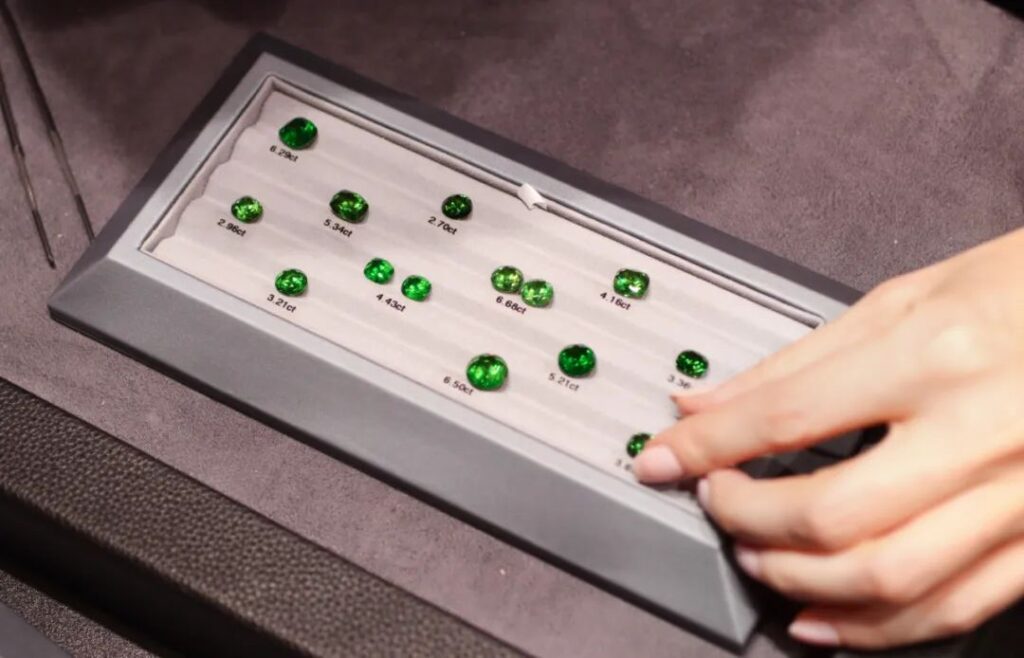
Despite their small carat sizes, many master jewelers are still enamored with demantoid garnets due to their unique fire and highly saturated green color.
For instance, JAR (Joel Arthur Rosenthal) capitalized on the demantoid’s penetrating, captivating green hue by concealing pavé-set demantoids behind a three-dimensional spiral of diamonds, allowing that fresh green to peek through subtly. Perhaps only demantoid garnets could accomplish this task, as other green gemstones would struggle to compete with the fire of diamonds.

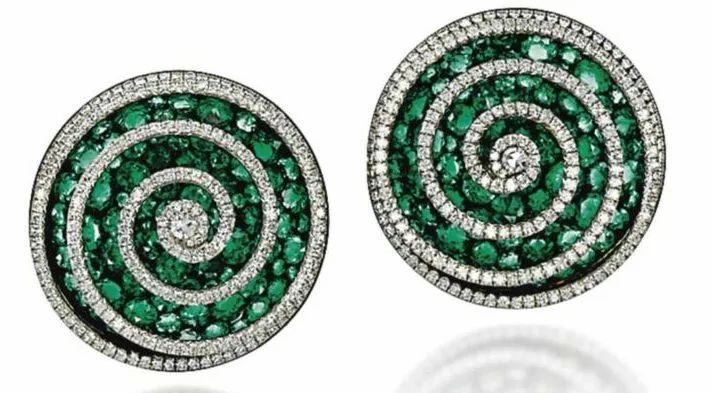
The German jewelry brand Hemmerle, renowned for its craftsmanship and creativity, frequently uses lesser-known gemstones and materials to create unexpectedly stunning pieces.
The brand excels at skillfully arranging various green gemstones to present harmonious gradations of color. They pair demantoid garnets with tourmalines, peridots, tsavorites, and even jade, showcasing a rich variety of green hues and textures. Of course, regardless of its pairing, the demantoid garnet always shines the brightest.

Demantoid garnet, tourmaline
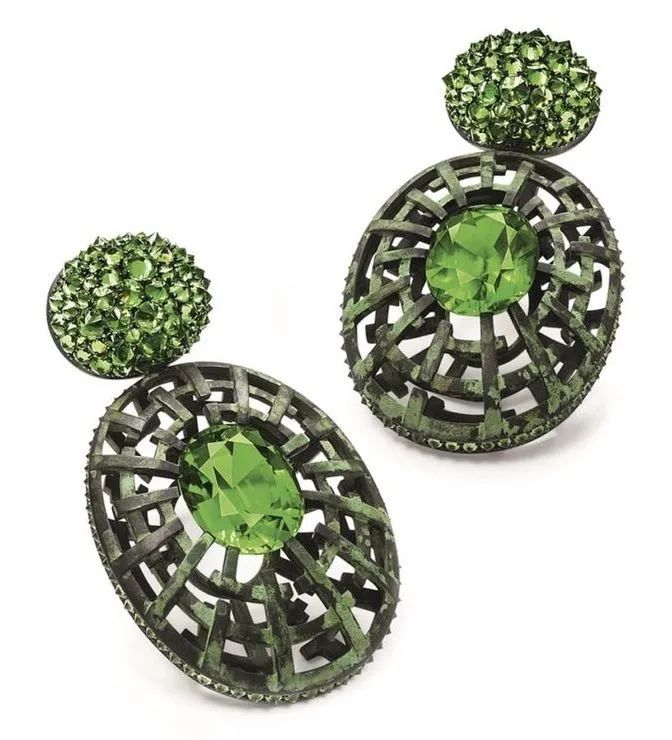
Demantoid garnet, peridot
The editor finds Hemmerle’s previous Infused Jewels collection particularly captivating. This collection used jewelry to recreate the “magical healing effects” of an herbal afternoon tea, with exquisite craftsmanship presenting lifelike “natural herbal essences.”
To create the green vitality of plants, demantoid garnets were essential for the finishing touch. For example, in a pair of strawberry earrings, only demantoid garnets could continue to emit a brilliant green light while encased in metal.
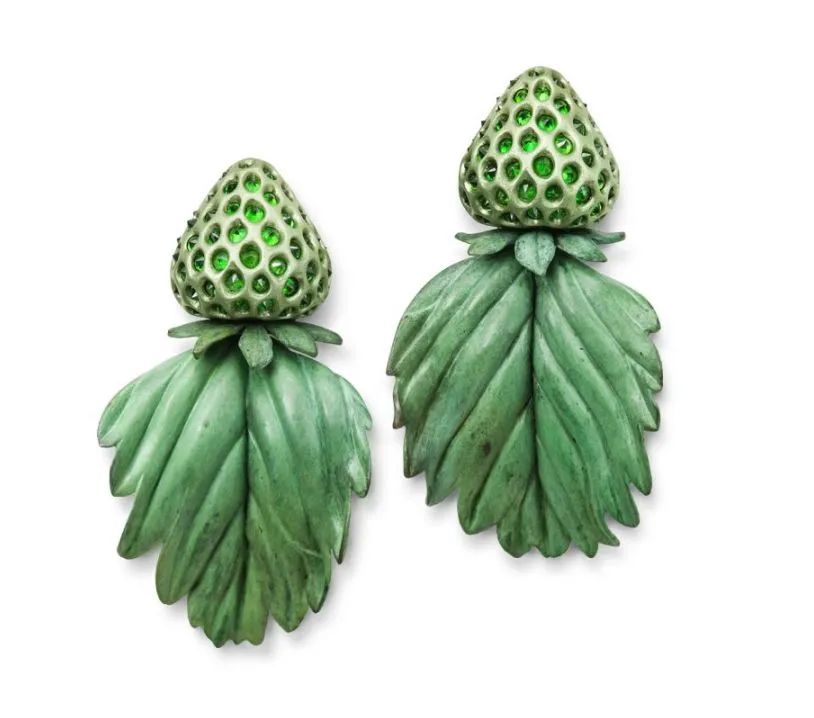
Infused Jewels Collection Strawberry Earrings
Copper, aluminum, white gold, demantoid garnet
After discussing so many rare garnets, one might think that January’s birthstone is out of reach. However, that’s not the case. Traditional rhodolite garnet is relatively affordable, and when most people think of garnet, they picture this pomegranate-like red stone.
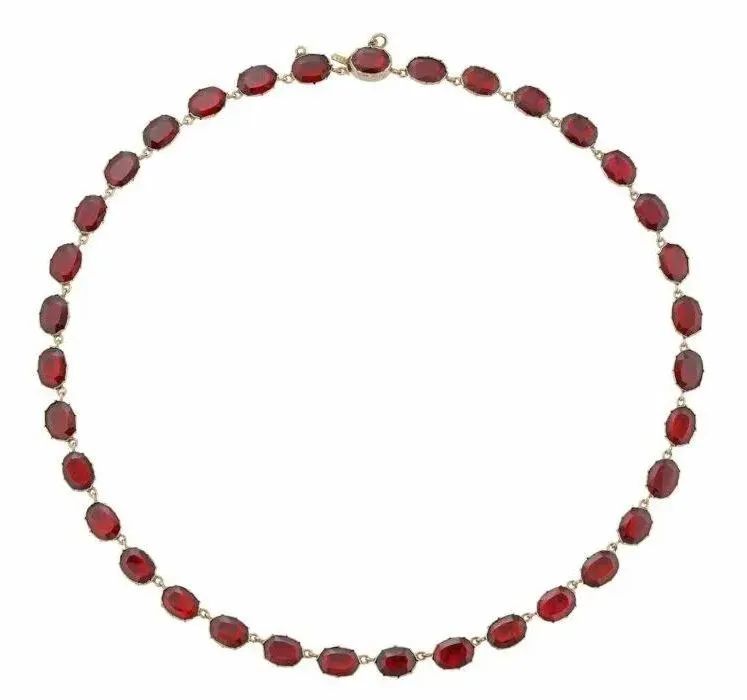
Georgian period garnet Riviere necklace
Circa 1800

Gold and garnet earrings, circa 1830
Rhodolite garnet is older than other family members. In ancient Egypt, pharaohs wore rhodolite garnet necklaces, which were buried with their mummies as precious possessions for the afterlife.
In Rome, rhodolite garnet was widely traded, and carved garnet signet rings were used to seal important documents. During the Georgian era, when jewelry became accessible beyond the nobility, rhodolite garnet became one of the main popular gemstones in jewelry. Later, it gained even more popularity due to Queen Victoria’s favor, becoming a jewelry choice from royalty to commoners, truly a “most popular item.”
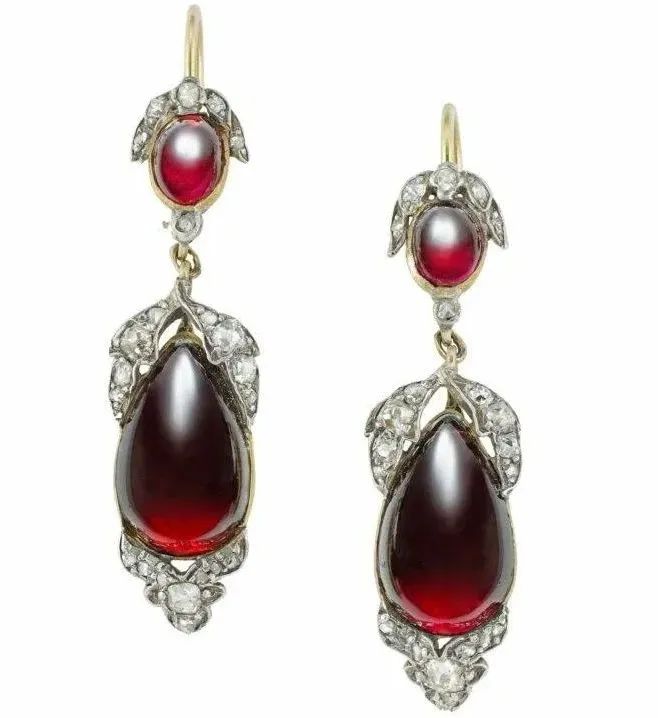
Victorian garnet earrings
Circa 1850
However, with the discovery of more gemstones and advancements in cutting techniques, rhodolite garnet gradually retreated from high-end jewelry due to its purplish-dark red hue and higher production. As a result, you rarely see rhodolite garnet in modern high-end jewelry pieces. But from another perspective, it’s an excellent choice for collecting antique jewelry!

Garnet and pearl necklace with cross pendant
Circa 1870
Firstly, rhodolite garnet became popular quite early, appearing frequently in royal collections from the 17th century. For instance, Louis XIV, the “Sun King,” owned an eagle brooch featuring a large heart-shaped red garnet. The Georgian and Victorian eras saw a surge in various rhodolite garnet jewelry, offering a wide range of choices in antique garnet jewelry, from styles to craftsmanship.
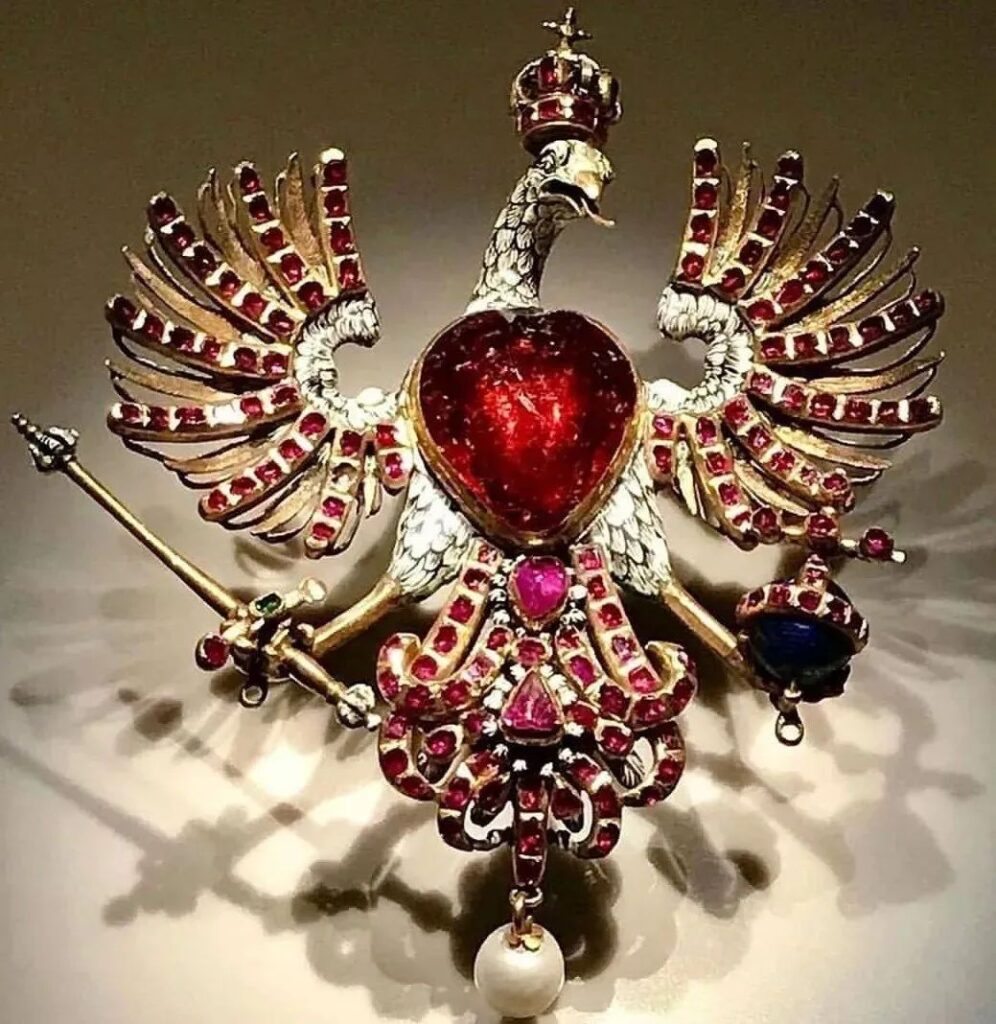
Currently in the Louvre Museum
Secondly, the unique charm of antique jewelry lies in the sense of history that time has bestowed upon it. Compared to contemporary jewelry, it comes with cultural, historical, craftsmanship, and rarity value. Choosing antique rhodolite garnet jewelry can easily “appreciate” its pure gemstone value, making it more collectible.
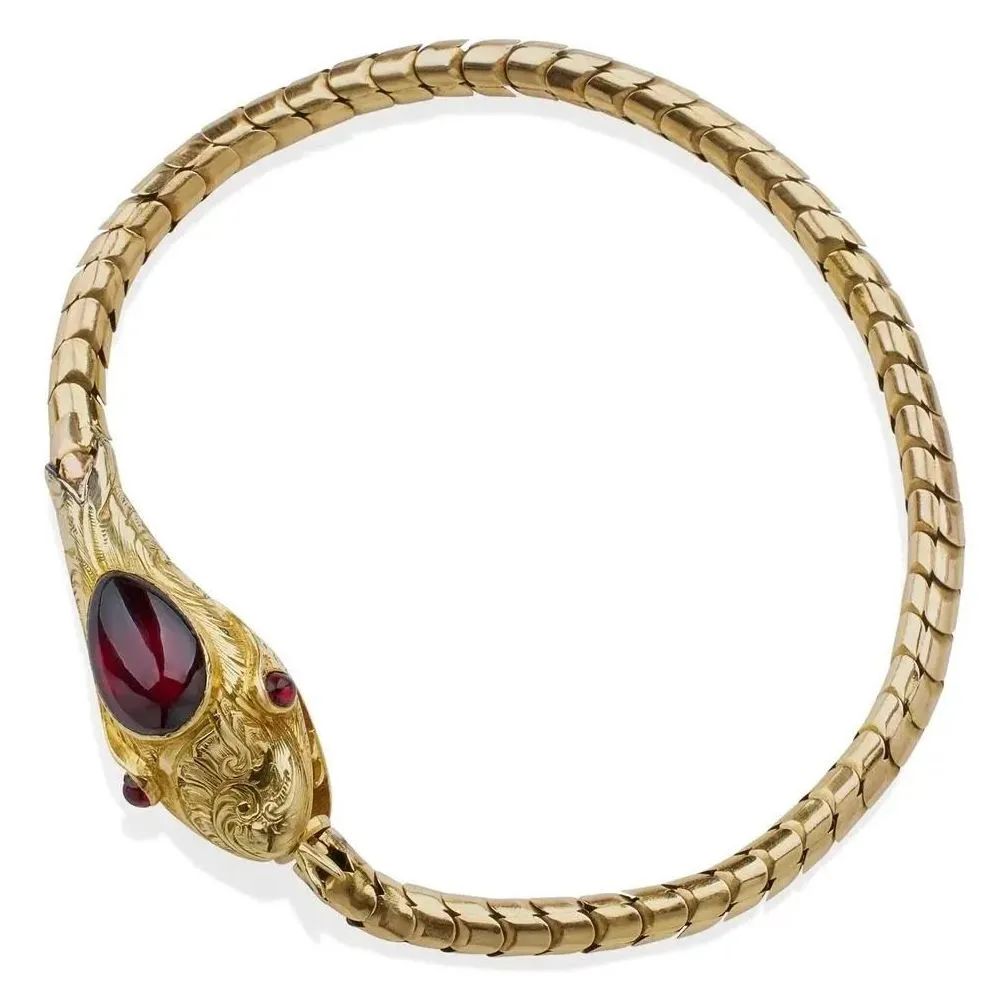
15K gold garnet snake bracelet
Circa 1880
Thirdly, there’s a cost-effectiveness advantage. Antique jewelry pieces set with diamonds, rubies, sapphires, and emeralds (the “traditional big three”) are quite expensive, especially if they have “celebrity effect” or “royal aura.”
However, rhodolite garnet antique jewelry is more affordable, allowing collectors to focus more on style, craftsmanship, and condition rather than just the gemstone, thus obtaining more cost-effective collection options.
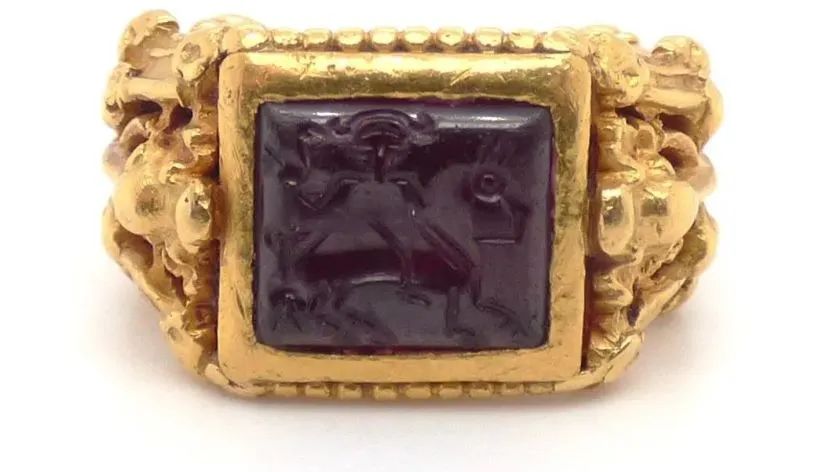
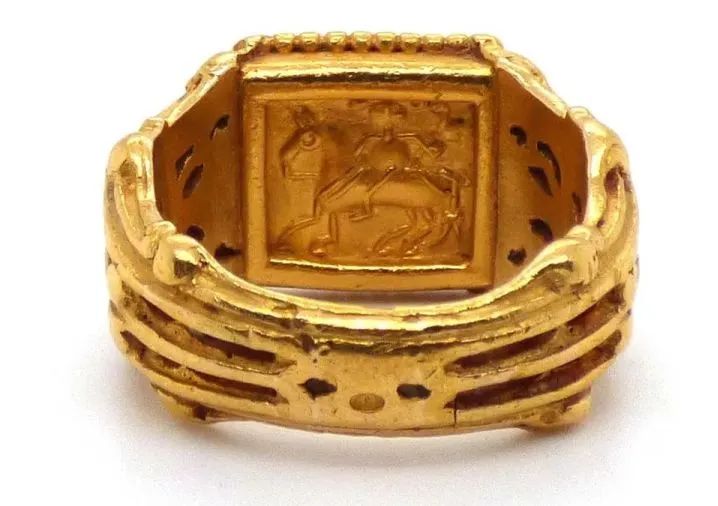
Circa 1867
As you can see, each member of the garnet family introduced today has its unique charm, and there’s surely one that suits you! If you were to acquire one, which would you choose?
Beyond Red: The Dazzling Diversity of the Garnet Family – A Deep Dive into High-Value Varieties
Tweet





